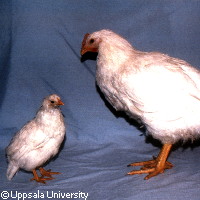How the wild chicken became the modern broiler
An international team of researchers led by scientists at Uppsala University in Sweden have achieved a breakthrough in genetic studies of domestic animals by demonstrating the genomic evolution of the modern chicken. The results are published in the journal Nature. The domestication of animals and plants by human beings so they could settle in one place, breed and begin farming the land is one of the most important factors that led to the development of our modern civilisation. Before they developed farming, human beings were mostly hunter gatherers, moving from place to place, killing animals for meat and skins and gathering roots and plants. The Uppsala University study describes how selective breeding led to the wild chicken becoming the modern food product found in markets. Today, chicken is not only probably the most popular meat in the world, but is the most important and cost-effective source of animal protein. At the beginning of the 20th century, specialised layer chickens (egg-producing ones) and broilers (for the pot) were bred. This led to huge improvements in chicken productivity. Research team coordinator Professor Leif Andersson from Uppsala University said, 'The strategy to study four different populations of layer chickens as well as four broiler populations allowed us to reveal genetic changes of crucial importance for chicken domestication in general as well as changes that were essential for the development of layers or broilers.' The genome sequence of the chicken was first established in 2004 by a research team that used a single female genome from a breed of chicken called red jungle fowl, the wild ancestor of the modern chicken. That project cost millions of US dollars. Because the team in this latest study used modern genome sequencing techniques developed in recent years, they needed a much smaller budget. Their research involved studying the genome sequence of both the red jungle fowl and eight different populations of the modern domestic chicken. 'This is the first study ever where the genetic diversity within and between populations are examined across the whole genome,' said team member Michael Zody, a researcher at the Broad Institute in the US. 'The new sequencing technologies allow us to address important biological questions that were impossible to study just a few years ago.' When animals are bred to improve their genes, something called a 'selective sweep' occurs. This is when a favourable gene mutation becomes fixed in a species. The researchers found that there was a selective sweep at the TSHR (thyroid stimulating hormone receptor) gene in chickens. In vertebrates, TSHR has a crucial role in metabolic regulation and the timing of reproduction as a response to changes in day length. In wild animals this is strictly controlled, preventing overpopulation by a particular species, but it has been drastically altered in modern chickens so they can lay eggs all year round. 'Our discovery that every domestic chicken that we have studied representing populations from Sweden to China carries a mutant form of the TSHR protein strongly suggests that this genetic change was an important step in the evolution of the domestic chicken,' said Professor Andersson. A second selective sweep in chickens involved the TBC1D1 gene that had previously been associated with obesity in humans. The TBC1D1 protein is involved in the regulation of glucose uptake in muscle cells. 'Our study shows that billions of broiler chickens worldwide carry a mutant form of the TBC1D1 gene and we are now very eager to identify the causative mutation at this locus and to reveal the molecular mechanism by which it impacts growth,' explained Dr Carl-Johan Rubin of Uppsala University. 'Our study has direct implications for animal breeding and enhances the importance of the domestic chicken as a model organism for biomedical research since we can so effectively reveal genes associated in changes in phenotypic traits,' Professor Andersson concluded.
Countries
Sweden, United States



